The Manual of Insight Published by Wisdom
After 16-year journey and the work of many
Written by: Steve Armstrong
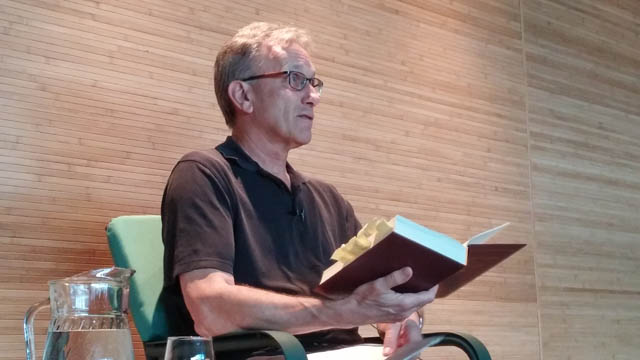
Steve Armstrong, who led the “Manual of Insight” translation team, in July presented on the book at Seattle Insight Meditation Society.
Photos by: Insight Meditation Society, Steve Wilhelm
This April, 16 years after I had a chance meeting with a former monastic friend in Burma, Wisdom Publications released Burmese master Mahāsi Sayadaw’s “Manual of Insight.”
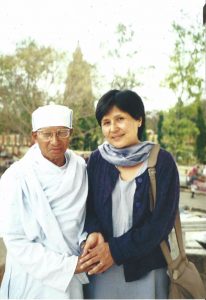
Kamala Masters, who also supported the project, with her teacher Munindra who previously studied with Mahasi Sayadaw.
e
The 700-page book offers, for the first time, a readable English translation of the primary work of one of 20th Century’s greatest Buddhist scholars and practitioners. The book is truly a manual, describing in clear detail how to do insight meditation, and how realization can progress.
Wisdom has published the “Manual of Insight” bound with a beautiful hard cover, which is gold-embossed and monastic robe-colored, befitting such an important work.
The lengthy work of translation has been subsidized and sponsored by Vipassana Metta Foundation, through the invitation of co-founders Kamala Masters of Maui and myself from Seattle.
As managing editor of the project, I assembled a team of translators, researchers and editors, all Burmese or Western monastics or former monastics in the Mahāsi Sayadaw tradition.
Mahāsi Sayadaw’s teachings have had a profound effect upon the transmission of Theravada Buddhadhamma to the West and other Asian countries. His own students Anagarika Munindra, Dipa Ma, and Sayadaw U Pandita, in turn taught the most senior Western mindfulness and insight dhamma teachers alive today.
It is his method of teaching, and his format of periodic intensive retreat practice, which I and other Western teachers have adapted as the basis for mindfulness meditation instruction and retreats.
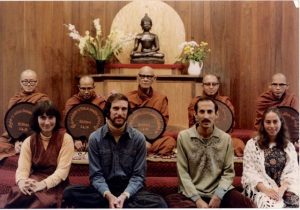
Mahasi Sayadaw, center, authorized teachers Sharon Salzberg, Joseph Goldstein, Jack Kornfield and Jacqueline Mandel, at IMS in 1979.
This includes retreats we have led at Cloud Mountain Retreat Center, Seattle Insight Meditation Society, and Bellingham Insight Meditation Society in Washington state; and the Bodhi Tree Sangha in Oregon. Teachers use the same methods at retreat centers across the United States, including Insight Meditation Society in Barre, Massachusetts, and Spirit Rock Meditation Center in California.
The significance of this work was recognized by Joseph Goldstein, co-founder of Insight Meditation Society, in his forward to the book. He wrote, “The widespread introduction of mindfulness, now taking place in America and other Western countries, has its roots largely in the teachings of Mahāsi Sayadaw and his great ability to convey the practical means of awakening.”
With the increasing number of secular applications of mindfulness across a wide spectrum of disciplines, it is timely that this book has appeared to remind us all that the direction of the teachings of the Buddha is toward liberation, freeing the mind/heart from suffering and the causes of suffering.
As Mahāsi Sayadaw affirms in his introduction to the book, it is insight understanding or vipassana knowledge that enables one to realize the end of suffering (dukkha), a freedom the Buddha described as the third noble truth.
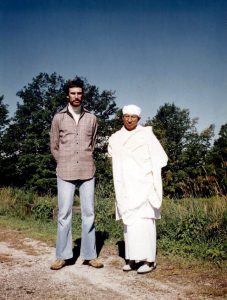
Munindra passed on the Mahasi Sayadaw legacy to Joseph Goldstein.
As a monk at the Mahāsi meditation center in Burma under the guidance of Sayadaw U Pandita, Mahāsi Sayadaw’s successor, I practiced this method of mindfulness. Through this I was able to establish the “momentary concentration,” described in the manual, which is sufficient to suppress the obsessive suffering I was familiar with from retreats in the U.S.
Additionally, I also soon understood that it was the development of the stages of insight enumerated in the “Manual of Insight,” which expose and eventually uproot the latent mistaken beliefs that cause suffering. The manual reveals the process of understanding that unfolds with insight, up to and including the realization of the unconditioned, or nibbāna. I had not been taught that roadmap during U.S. retreats!
Returning to the U.S. after five years as a monk in Burma, I in 1991 started teaching mindfulness meditation for the development of liberating insight at Cloud Mountain Retreat Center in Castle Rock, Washington. I also for the next 17 years co-taught the annual three-month retreat at IMS.
I soon learned from my co-teaching team members, that teaching exclusively from the progress of insight often conditions people to excessively strive to “attain” spiritual experiences. Such over-efforting actually impedes the natural unfolding of insight.
In response, the first generations of Western mindfulness teachers for the most part avoided speaking about the progress of insight up to nibbāna, as laid out in this manual.
Years to accurately translate the book
After my monastic friend Hla Myint first translated and edited the “Manual of Insight,” Kamala Masters and I offered a short study course of the book at the Barre Center for Buddhist Studies, in Massachusetts.
Then Ven. Ariyañāni, a Swiss nun living in Burma who was visiting the Barre Center, kindly pointed out how our edition could be considerably improved. Her re-translation was immediately followed by Deborah Ratner Helzer and Kamala re-editing the manuscript, supported by several other senior students of the Mahāsi method. This took several more years to complete.
In addition, when on my annual visits to Burma I would consult with my preceptor, Sayadaw U Pandita, who served as our advisor to the project. He died in April of this year.
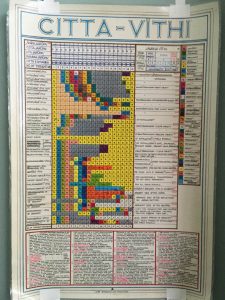
One of the tables Steve Armstrong created, of Abhidhamma details, which can be found in the back of the “Manual of Insight.”
After I asked Sayadaw U Pandita whether we could omit the 599 Pali language quotes from the English version of the book, after several minutes of careful consideration, he suggested it would be better to include them.
A bit dismayed, I thought surely no publisher is going to want to include them! But then Sayadaw explained how Mahāsi Sayadaw himself always documented everything he wrote, from sources in the Pali canon and from other Pali language commentaries and sub-commentaries.
When I protested that very few English-speaking people studied or could read the Pali language, he acknowledged as much. But he suggested that might change in the future, when such scholars might want to be able to check the original sources for themselves.
This decision sent us on a two-year search by Ven Virañāni, an American nun living in Burma, to locate the quotes in Roman script Pali language sources. We needed these because non-Burmese people wouldn’t be able to read the Burmese script editions of the sources.
Additionally, much of what is referenced in the manual comes from the Abhidhamma, the third basket of the Buddha’s teachings, which is so loved in Burma. This necessitated designing several tables of information to help readers understand this material, which is relatively unknown among Western dhamma students.
I had previously studied the Abhidhamma with senior Burmese monks, and with their help had drawn by hand charts displaying much of what is encoded in the Abhidhamma. Now I was tasked with transferring it all to computer-based spreadsheets, to be included in the book as appendices.
Fortunately, when we submitted our completed manuscript to Wisdom Publications editor Andy Francis immediately realized the quality, value and significance of the manual’s material, for all devoted practitioners of any Buddhist tradition.
We were able to work with him over the next 18 months to edit the book for publication, design the production of a fold-out chart of Abhidhamma appendices to tuck into a back cover pocket. We also collaborated to locate Pali language sources for the many quotes, and to compile an extensive Pali-English and English-Pali glossary.
Proceeds from Wisdom Publication’s sale of the “Manual of Insight,” will in turn be used by the Vipassana Metta Foundation to distribute copies of book freely to monastics, libraries, and meditation centers.
From Sept. 22 through Nov. 12, Kamala Masters and I will be offering an eight-week, on-line “Introduction to the Manual of Insight.” This will be through a collaboration between the Barre Center for Buddhist Studies and Wisdom Academy, a division of Wisdom Publications. This on-line offering is bound to spark renewed interest and deepen your dhamma comprehension.
